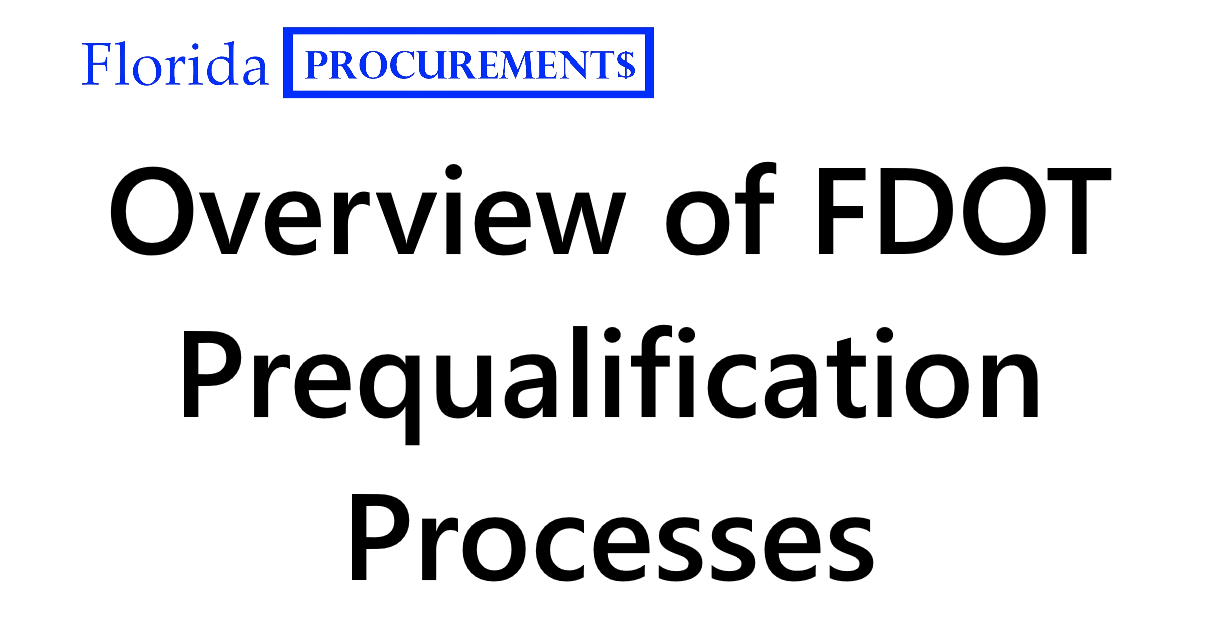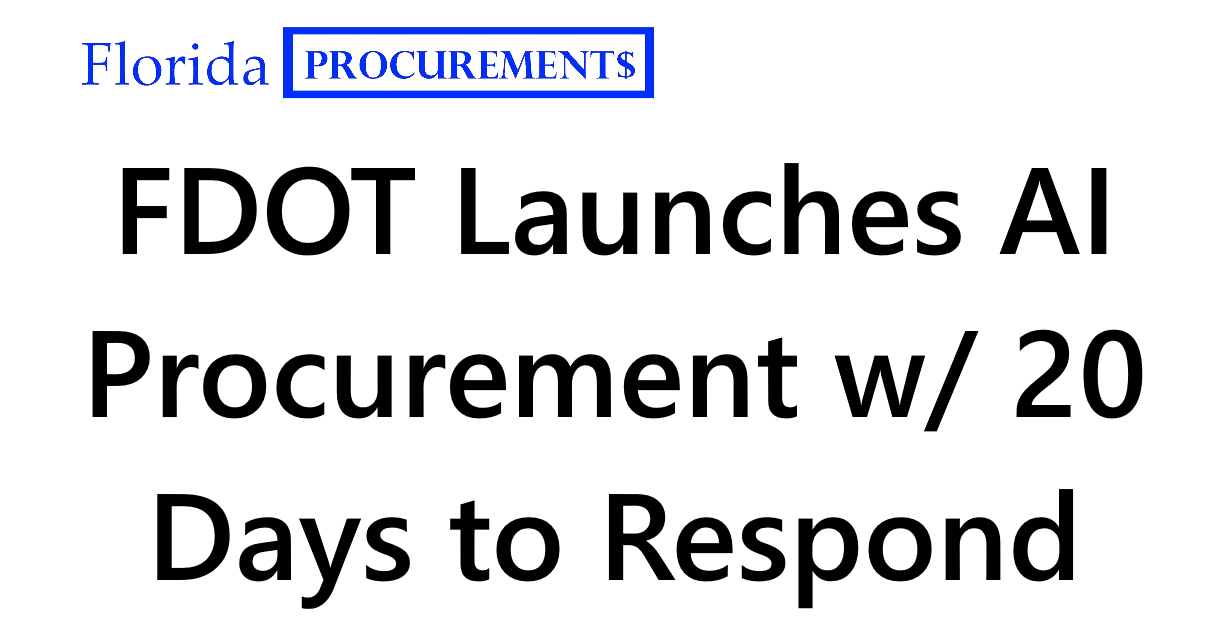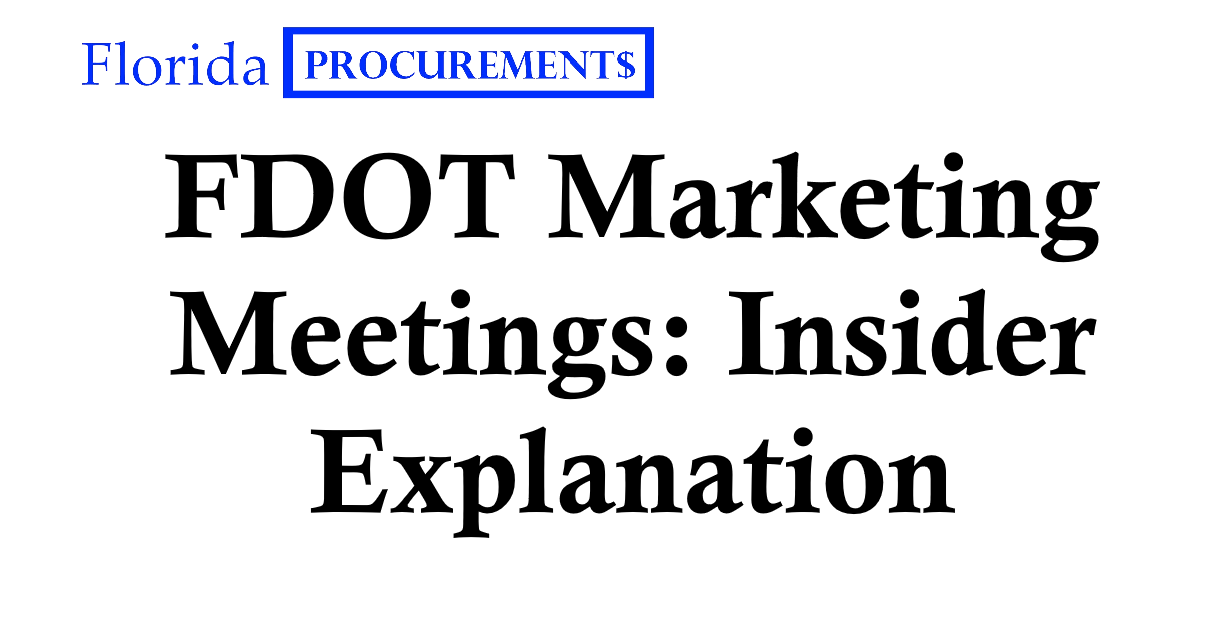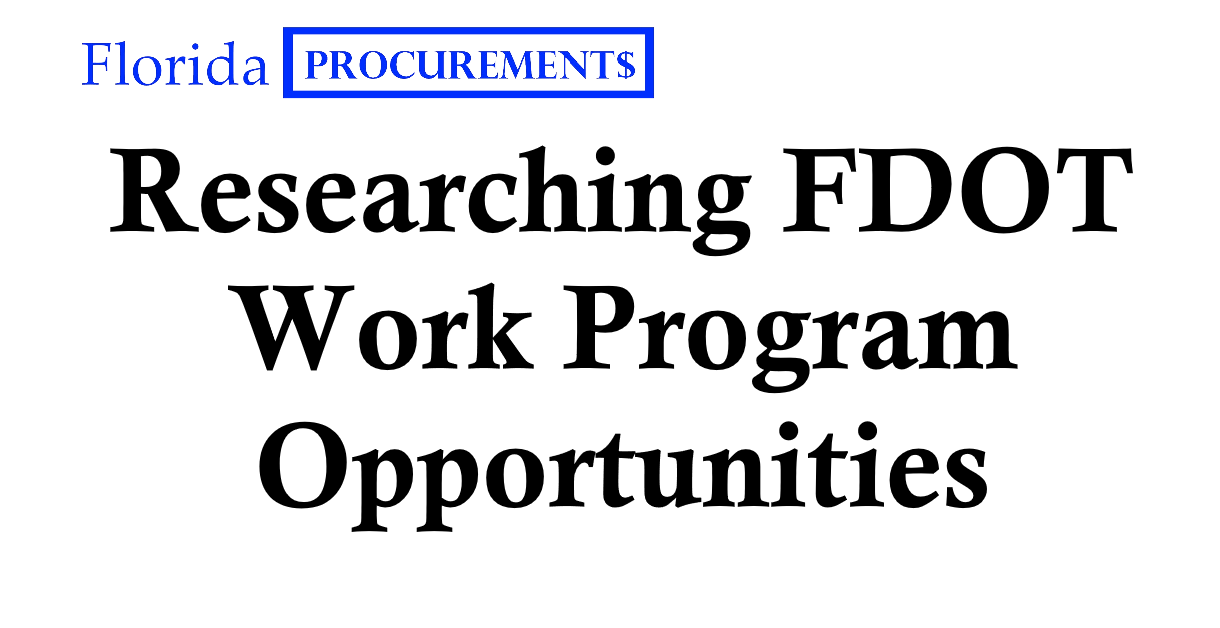
- May 15, 2025
- Sean Gellis
- 0
Welcome to FloridaProcurements.com (FlaProc), your authoritative resource for navigating Florida’s government contracting landscape, with particular focus on transportation and technology opportunities. FlaProc provides free, expert guidance to help companies identify and secure state contracting opportunities throughout Florida.
This resource is maintained by Attorney Sean Gellis of Gellis Law, PLLC, one of less than 75 attorneys Board Certified in State and Federal Government and Administrative Practice by The Florida Bar. Mr. Gellis brings unique insight to government contracting, having served as the Chief of Staff of the Florida Department of Management Services (DMS), General Counsel of the Florida Department of Transportation (FDOT), and Deputy General Counsel of the Florida Office of Insurance Regulation – positions that provided direct oversight of technology initiatives and issues of statewide importance. His record in bid protest litigation reflects the sophisticated advocacy and strategic thinking he brings to government contracting matters, particularly in complex transportation and technology procurements. Sean also leads Procurement Insider, a confidential subscription service that provides technology vendors with strategic intelligence and insider analysis of Florida government opportunities. Learn more about transforming your approach to government contracting at www.gellislaw.com/procurement-insider
The Complete Guide to FDOT Prequalification: Your Gateway to Florida Transportation Contracts
As the former General Counsel of the Florida Department of Transportation, I’ve witnessed thousands of companies navigate the prequalification process – some seamlessly, others facing unnecessary delays and frustrations. Today, I’m sharing everything you need to know about FDOT prequalification, whether you’re a first-time applicant or an experienced firm looking to expand your capabilities.
What Is FDOT Prequalification?
Before we dive into the details, let’s address the fundamental question: what exactly is FDOT prequalification?
Simply put, prequalification is FDOT’s way of ensuring that companies have the necessary expertise, resources, and track record to successfully complete transportation projects. Think of it as getting vetted before you can even compete – it’s FDOT’s quality control mechanism that protects both the agency and Florida’s taxpayers.
The Florida Department of Transportation manages one of the nation’s largest state transportation budgets, overseeing billions in annual infrastructure investments. With projects ranging from routine maintenance to complex interstate expansions, FDOT needs assurance that contractors and consultants can deliver quality work on time and within budget.
Two Distinct Paths: Professional Services vs. Construction
One of the most common misconceptions I encountered was confusion between professional services and construction prequalification. These are two entirely different processes with distinct requirements:
Professional Services Prequalification
- Required for: Engineering, design, planning, environmental studies, and technical consulting
- Threshold: Required for ANY amount of work in designated technical areas
- Duration: Typically valid for multiple years with annual updates
- Focus: Technical expertise, staff qualifications, and past project performance
Construction Prequalification
- Required for: Construction contracts exceeding $250,000
- Threshold: Projects under $250,000 don’t require prequalification
- Duration: Annual renewal required
- Focus: Financial capacity, bonding ability, and construction experience
This article focuses primarily on professional services prequalification, though many principles apply to both paths.
Why Companies Pursue FDOT Prequalification
During my tenure at FDOT, I observed several compelling reasons why firms invest in prequalification:
1. Access to Significant Opportunities
FDOT manages Florida’s state highway system, including:
- Over 12,000 centerline miles of highway
- Nearly 7,000 bridges
- Major interchanges and intersections
- Rest areas and weigh stations
- Intelligent Transportation Systems
This translates to hundreds of millions in annual professional services contracts.
2. Predictable Pipeline of Work
Unlike private sector volatility, FDOT operates on multi-year work programs with predictable funding cycles. Prequalified firms can plan their business development around known upcoming projects.
3. Prime Contractor Opportunities
Prequalification allows firms to serve as prime contractors on major projects, not just subconsultants. This means:
- Direct client relationships
- Higher profit margins
- Greater control over project execution
- Enhanced firm reputation
4. Growth and Diversification
Many firms use FDOT prequalification as a stepping stone to:
- Other state agency work
- Local government contracts
- Private sector transportation projects
- Regional and national expansion
Understanding FDOT’s Work Type Categories
FDOT organizes professional services into specific work types, each requiring separate prequalification. Think of these as specialized certifications – being qualified for roadway design doesn’t automatically qualify you for bridge inspection.
Major Work Type Categories
Project Development & Environmental (PD&E) Studies
- Corridor analysis
- Environmental impact assessments
- Public involvement programs
- Alternative analysis
- Preliminary engineering
Roadway Design
- Highway geometrics
- Pavement design
- Drainage systems
- Maintenance of traffic
- Intersection improvements
Bridge Design
- Structural analysis
- Load ratings
- Rehabilitation design
- New bridge design
- Specialty structures
Traffic Operations
- Signal design
- ITS infrastructure
- Safety studies
- Traffic analysis
- Signing and marking
Geotechnical Services
- Subsurface investigations
- Foundation recommendations
- Slope stability analysis
- Materials testing
- Pavement evaluation
Construction Engineering & Inspection (CEI)
- Construction oversight
- Materials testing
- Contract administration
- As-built documentation
- Project closeout
Surveying and Mapping
- Right-of-way surveys
- Topographic mapping
- Control surveys
- GIS services
- Utility location
Planning Studies
- Transportation planning
- Transit planning
- Freight planning
- Multimodal studies
- Economic analysis
Each category often includes subcategories requiring specific expertise. For example, bridge design might separate into:
- Simple span bridges
- Complex bridges
- Movable bridges
- Bridge inspection
- Load rating analysis
The Prequalification Process: A Step-by-Step Guide
Let me walk you through the actual process, incorporating lessons learned from hundreds of successful applications:
Step 1: Initial Assessment (Weeks 1-2)
Before starting your application, conduct an honest assessment:
Company Readiness Checklist:
- Professional liability insurance in place
- Florida-licensed professional engineers on staff
- Documented project experience in desired work types
- Quality assurance procedures established
- Financial statements current and audited
- Key staff committed to the process
Strategic Questions to Answer:
- Which work types align with our core competencies?
- Do we have adequate project examples?
- Is our staff experience well-documented?
- Should we start with fewer work types and expand later?
Step 2: Documentation Gathering (Weeks 3-4)
The most time-consuming part of prequalification is gathering required documentation:
Essential Documents:
- Professional Licenses
- Current Florida PE licenses for key staff
- Firm’s certificate of authorization
- Other relevant professional certifications
- Insurance Documentation
- Professional liability certificate
- General liability coverage
- Workers’ compensation
- Automotive liability
- Financial Information
- Audited financial statements (typically 3 years)
- Banking relationships
- Bonding capacity letters
- Credit references
- Organizational Documents
- Corporate structure
- Ownership information
- Office locations
- Staff organizational chart
Step 3: Work Type Selection (Week 5)
Strategic work type selection is crucial. I’ve seen firms fail by overreaching initially. Consider:
Start Conservative
- Choose 2-3 core work types initially
- Ensure strong project examples for each
- Verify staff qualifications align
- Plan for future expansion
Analyze Market Opportunities
- Review FDOT’s Five-Year Work Program
- Identify upcoming projects
- Assess competition in each work type
- Consider geographic factors
Step 4: Staff Documentation (Weeks 6-7)
This is where many firms struggle. FDOT requires detailed staff information:
For Each Key Employee:
- Professional resume (FDOT format preferred)
- Education verification
- License documentation
- Project-specific experience
- Role in proposed work types
- Years with the firm
Critical Staff Positions:
- Project managers
- Technical leads
- Quality control managers
- Discipline leaders
- Principal-in-charge
Step 5: Project Experience (Weeks 8-9)
Your project examples make or break the application:
For Each Project:
- Project name and location
- Client contact information
- Contract value and duration
- Scope of services
- Key staff involvement
- Complexity factors
- Quality measures implemented
- Outcomes achieved
Selection Criteria:
- Recent projects (within 5 years preferred)
- Similar scope to FDOT work
- Successful completion
- Demonstrable quality control
- Client satisfaction
Step 6: Quality Assurance Documentation (Week 10)
FDOT takes quality seriously. Your QA/QC plan should address:
Essential Elements:
- Review procedures for each work type
- Staff responsibilities
- Checking protocols
- Document control systems
- Error tracking and correction
- Continuous improvement processes
- Training programs
- Performance metrics
Step 7: Application Submission (Week 11)
With everything prepared, submission involves:
- Online application completion
- Document upload
- Application fee payment
- Certification statements
- Electronic submission
Step 8: Review and Response (Weeks 12-16)
After submission:
- FDOT conducts initial review
- Clarification requests may arrive
- Respond promptly to all inquiries
- Provide additional documentation if requested
- Track application status online
Common Pitfalls and How to Avoid Them
Through my years at FDOT, I’ve identified recurring issues that delay or derail applications:
1. Insufficient Project Documentation
The Problem: Firms provide project lists without substance The Solution: Create detailed project narratives including:
- Specific challenges addressed
- Technical innovations employed
- Staff roles and contributions
- Quality control measures
- Client satisfaction evidence
2. Misaligned Staff Experience
The Problem: Staff experience doesn’t match work type requirements The Solution:
- Map individual experience to specific work types
- Document relevant continuing education
- Show progression of responsibility
- Highlight Florida-specific experience
3. Generic Quality Assurance Plans
The Problem: Boilerplate QA/QC documents that don’t address FDOT specifics The Solution:
- Customize for each work type
- Reference FDOT standards
- Include specific review procedures
- Demonstrate actual implementation
4. Outdated Information
The Problem: Using old project data or departed staff The Solution:
- Update all information regularly
- Verify current staff availability
- Confirm project contact information
- Review insurance coverage dates
5. Overly Ambitious Scope
The Problem: Applying for too many work types initially The Solution:
- Start with core competencies
- Build track record gradually
- Add work types systematically
- Focus on quality over quantity
Maintaining Your Prequalification
Achieving prequalification is just the beginning. Successful firms understand that maintaining their status requires ongoing attention:
Annual Requirements
- Update financial information
- Refresh project examples
- Confirm staff availability
- Verify insurance coverage
- Report significant changes
Continuous Improvement
- Track FDOT project performance
- Document lessons learned
- Invest in staff development
- Monitor industry trends
- Expand capabilities strategically
Relationship Building
- Attend FDOT industry meetings
- Participate in pre-proposal conferences
- Network with FDOT staff appropriately
- Join relevant professional associations
- Collaborate with other prequalified firms
Strategic Considerations for Success
Based on my experience, successful prequalified firms share certain characteristics:
1. Long-term Perspective
They view prequalification as an investment, not an expense. Initial costs and effort pay dividends through years of contract opportunities.
2. Quality Focus
They prioritize project quality over volume, understanding that FDOT values consistent, high-quality delivery.
3. Staff Development
They invest in their people through:
- Continuing education
- FDOT-specific training
- Cross-functional experience
- Leadership development
4. Strategic Partnerships
They build relationships with:
- Other prequalified firms
- Specialty subconsultants
- DBE partners
- Industry associations
5. Market Intelligence
They stay informed about:
- FDOT’s strategic priorities
- Upcoming project opportunities
- Industry trends
- Regulatory changes
Resources and Next Steps
Ready to pursue FDOT prequalification? Here’s your action plan:
Immediate Actions
- Review FDOT’s current work type listings
- Assess your firm’s qualifications
- Identify gaps in capabilities
- Assign a prequalification champion
- Set realistic timelines
Resources to Leverage
- FDOT’s Professional Services website
- Industry association guidance
- Prequalified firm partnerships
- Professional conferences
- FDOT training sessions
Common Questions Answered
Q: How long does prequalification take? A: Typically 3-4 months from start to approval, assuming complete documentation
Q: What’s the minimum firm size? A: No minimum, but must demonstrate adequate resources for intended work
Q: Can out-of-state firms qualify? A: Yes, but must have Florida-licensed professionals and demonstrate Florida presence
Q: How much does it cost? A: Application fees vary by work type, plus costs for documentation preparation
Q: Is prequalification guaranteed? A: No, FDOT evaluates each application against established criteria
Looking Ahead
FDOT’s prequalification process continues evolving to meet industry needs. Recent trends include:
- Increased emphasis on innovation
- Sustainability requirements
- Technology integration
- Performance metrics
- DBE participation goals
Successful firms anticipate these changes and position themselves accordingly.
Final Thoughts
FDOT prequalification opens doors to significant opportunities in Florida’s transportation sector. While the process requires dedication and resources, the potential rewards justify the investment for firms committed to transportation infrastructure.
Remember, prequalification is more than checking boxes – it’s about demonstrating your firm’s capability to deliver quality work that serves Florida’s transportation needs. Approach it strategically, prepare thoroughly, and maintain your status diligently.
Whether you’re a small specialty firm or a large multi-disciplinary company, FDOT prequalification can be a cornerstone of your business development strategy. The key is understanding the process, preparing systematically, and executing professionally.
Need specific guidance on your FDOT prequalification journey? Stay tuned to FloridaProcurements.com for detailed articles on each aspect of FDOT contracting, or reach out for strategic counsel on your unique situation.






